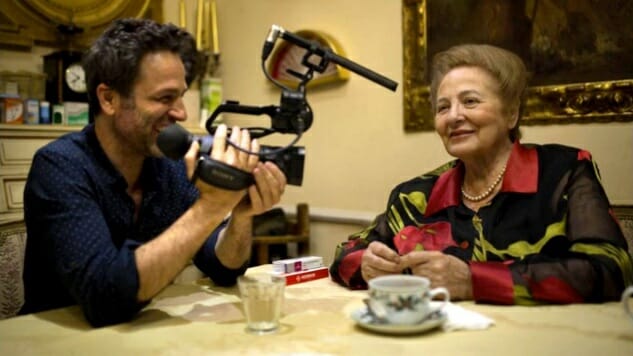
The biggest possible critic of Lots of Kids, a Monkey and a Castle, famous Spanish actor Gustavo Salmeron’s affable, refreshingly transparent, and loving documentary about his mother, is the main character of his own movie, the mother herself. During the multiple casual interviews Salmeron conducts with Julita, the larger-than-life-in-all-ways-imaginable 81-year-old matriarch of her sprawling family, she keeps bluntly telling her son that, while the finished film would probably make an entertaining home video, no one else would be interested in watching her ramblings.
She’s so disillusioned with Gustavo’s little love letter to her near the end of the project that she even considers not letting him use her image for the movie, essentially dooming its chances for a commercial release. It’s not the intimately personal details about her life and past—some of which must have been very painful to share—that bothers her. She worries not about her exposure to an audience who do not know her personally, but to the audience who she’s certain will be bored to tears listening to the ramblings of an old Spanish lady. She instructs her son to make movies with interesting screenplays and compelling characters, not whatever dreck he’s involved in that very moment. By doing this, she becomes instantly interesting, and inadvertently counters her own argument.
Yet in some ways, she has a point. My screenwriter teacher during grad school drilled the mantra into us that “the minutia of our lives do not automatically make great stories.” Our personal experiences might be fascinating drama for us, but for the general audience it might come across as self-serving, narcissistic art; however, there’s a difference between the typical “My granpappy came to this country with 80 cents in his pocket and a head full of dreams,” and the not so typical, “All my mother wanted out of life was lots of kids, a monkey and a castle. She somehow got all of those things, and is now on a quest to find her grandmothers’ vertebrae hiding in a random box in her castle.” The second premise is so bonkers and open to so many questions, that it should automatically trigger a documentary crew to get to the bottom of it.
At this point, there’s probably a need for some clarification, just not too much—viewers should discover some of this crazy family’s story on their own. As mentioned above, the title refers to Julita’s aspirations in life. She wanted a lot of children to love, and got that wish. For some reason, she wanted a monkey, and got that, too. Although, she later learns that her pet monkey was, you know, an actual primate instead of a cuddly Disney character, leading to a tragicomical resolution. She always wanted to live in a castle like a princess, yet growing up in a working class family she knew how unattainable this fantasy was. The chaos of life sometimes works in our favor, and a sudden flow of cash from an inheritance actually allowed her to buy a small castle and fill it to the brim with possessions from her past, stacked up in an endless array of boxes like a U-haul version of the final shot from Raiders of the Lost Ark.
Julita’s certain that inside one of those boxes is pieces of her grandmother’s vertebrae, which were collected and stored by her grandfather after his wife was killed by soldiers and wasn’t properly buried, leading to bugs eating her flesh. With only bones left, the grandfather decided to keep some especially macabre souvenirs to remember her by. The search for the vertebrae by Salmeron and his crew provides the doc with well-needed narrative glue, especially considering how his need to cover all aspects of his mother results in some unfocused and episodic editing. The quest for the grandmother’s bones and Julita’s unwillingness to clear out the boxes that haunt her castle organically speak to the question of whether or not we should cling to our past as a continuation of our bloodline, or leave it behind and move on as our own unique entities? To its credit, Lots of Kids, a Monkey and a Castle does not provide any easy answers.
Full of over and underexposed shots and various digital video noise, Salmeron’s film was obviously shot by either a skeleton crew, or by the director and his friends in their spare time. Some of this amateur look is obviously on purpose, to aesthetically have the project resemble a home video. Salmeron uses jump cuts and the academy ratio to capture the homegrown feel of his family’s old 8mm footage. On the other hand, there might have been budgetary constraints, but even then, in a world where iPhone footage competes with professional hardware, Salmeron’s film could have looked more attractive. (There are images here that look like they’ve been shot using a consumer MiniDV camera from 1999.)
The final product is also too long by about fifteen minutes. The middle chunk, before the third act once again intensifies with the search for the family bones, resembles a no-budget pilot for a Spanish version of Hoarders, as we become privy to a dull procedural, watching Gustavo and his siblings clear out and move the junk in the castle. Yet even with its technical shortcomings, Lots of Kids, a Monkey and a Castle should satisfy fans of intimate slice-of-life docs about eccentric families, like Grey Gardens and Tarnation.
Director: Gustavo Salmeron
Starring: Julita Salmeron, Gustavo Salmeron
Release Date: December 14, 2018